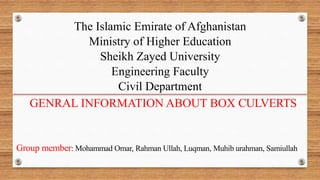
Box culvert
- 1. GENRAL INFORMATION ABOUT BOX CULVERTS Group member: Mohammad Omar, Rahman Ullah, Luqman, Muhib urahman, Samiullah The Islamic Emirate of Afghanistan Ministry of Higher Education Sheikh Zayed University Engineering Faculty Civil Department
- 3. Content s Bridge Definition . What is Culvert. Type of Culverts. Difference between Bridge and Culverts. Introduction of Box Culvert. Components of Box Culvert Important point about Box culvert. Box culvert construction method. APPLICATIONS ADVANTAGES OF BOX CULVERT.
- 4. BRIDGES: Bridge is a structure which is made up between highway Railway and river used to transfers animal, people and vehicles Classified as: Minor Bridges – Span greater than 6m up to 60m Major Bridges – Span greater than 60m
- 5. CULVERT • Culvert is a cross-drainage structure having a total length of 6m. • The types of culverts are: 1-Box culvert(a box culvert is a structure which consisting of two horizontal and vertical slabs.) 2-Pipe culvert 3-RCC solid slab culvert 4-Arch culvert
- 6. BOX CULVERT Pipe culvert RCC solid slab culvert Arch culvert
- 7. S.NO BRIDGES CULVERTS 1 A bridge is a passage of transportation (for people or vehicles) over a large body of water or physical obstruction. A culvert is generally a tunnel-like structure that allows to pass under a roadway or railway. 2 The basic components of a bridge are superstructure (supports load), substructure (transfers load to foundation soil) and deck (transfers surface load to other components). The components of a culvert are comparatively simpler and include concrete boxes or cells (single or multiple), pipes, a top deck or slab and supporting parts. 3 Bridges are constructed at a height more than 20 feet. Culverts are built at less than 20 feet high over the obstruction. 4 A bridge spans from 6 meters (minor bridges) to more than 120 meters. The length of culverts is typically not more than 6 meters. 5 The construction of a strong and deep foundation is very important in building a bridge. The foundation along the entire breadth supports the bridge. No deep foundation is required for a culvert.
- 8. The culvert consisting of one or more numbers of rectangular or square openings, having their floor and top slabs constructed monolithically with abutments and pier, is known as box culvert. BOX CULVERT
- 9. Components of box culverts • Bottom slab • Vertical walls • Deck slab • Haunch • Wing wall • Return wall • Drop wall • Curtain wall • Earth retainer
- 10. • A four sided culverts are typically referred to as box culverts. • Standard box sizes : 0.9*0.6m to 3.6*3.6 in 0.3 m span and raise increments. • 3 sided structure is a u shaped structures that may or may not have a crown in the center • and its size range from 2.5m to 15m span lengths . • Box culverts are mainly constructed where the soil is soft and the load has to be distributed over a wider foundation area. • Box culverts are made up of concrete and especially RCC(reinforced concrete cement). BOX CULVERT
- 11. BOX CULVERT • The most challenging part in constructing a box culvert is that dry surface is needed for • installing it • However ,due to strength of the concrete floor ,water , direction can be changed when a large amount of water is expected. • This feature makes box culverts , one of the most commonly found types of the culvert.
- 12. WET CAST METHOD •Typically cast on end using outer and inner form •Cast with conventional concrete or self consolidation concrete •Product cured in the form •Wet cast is commonly used in sanitary application DRY CAST METHOD (MACHINARY METHOD ) •product cast using mechanized equipment •Product is immediately stripped and the form is reused
- 14. Box culverts are subject to: • Lateral earth loads from soil and hydrostatic loads from ground water. • Vertical loads from the cover soil and live loads above. • Surcharge loads from nearby impact loads. • Seismic loads where applicable.
- 15. APPLICATIONS Box culverts • Short-span bridges (over highways, waterways, railways, for golf courses, etc.) • Conveyance of storm water, sewage or industrial wastes (storm drains) • Tunnels (to house conveyers, utilities, etc; to provide access, escape routes, etc.) • Detentions 3 sided culverts • short -span bridges(flat and arched)
- 16. ADVANTAGES OF BOX CULVERT • The box culvert is a rigid frame structure and very simple in construction • It is suitable for non-perennial streams where scrub depth is not sufficient but the soil isweak • The bottom slab of the box culvert reduces pressure on the soil • Box culverts are economical due to their rigidity and monolithic action and separate foundations are not required • It is used in a special cases , weak foundation.
- 17. References 1. Johnson victor, D., Essentials of bridge engineering, (fifth edition), Oxford & IBH Publishing co. Pvt. Ltd. New Delhi, 2001, 2. Krishna Raju, Design of Bridges (Fourth Edition), Oxford & IBH Publishing co. Pvt. Ltd. New Delhi, 2009,
- 19. Questions